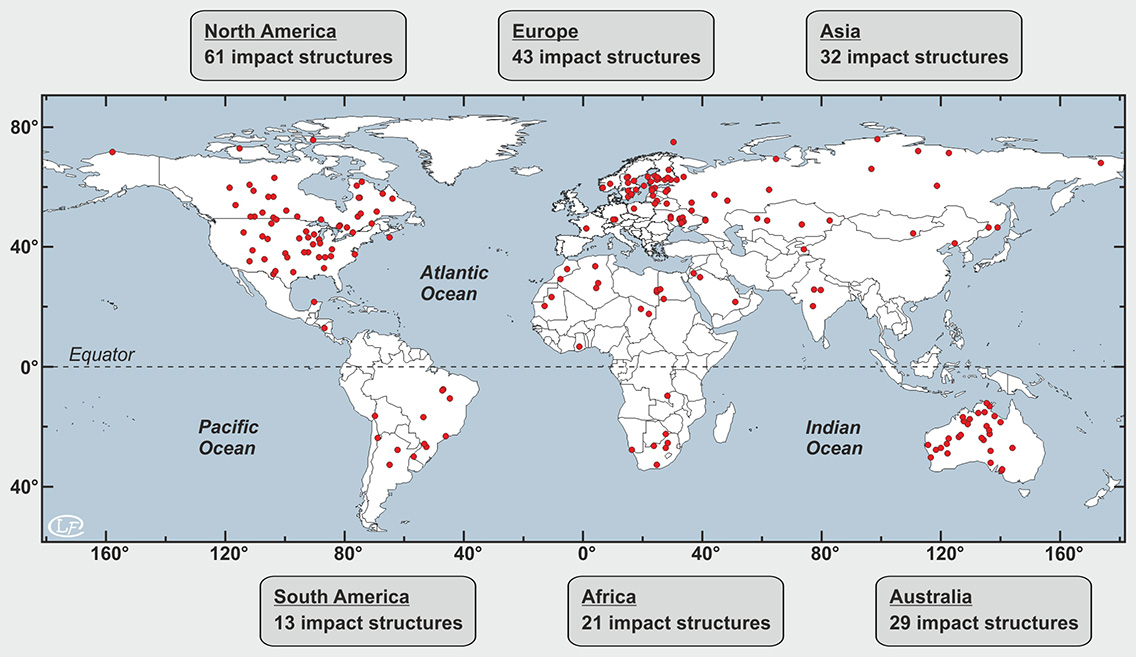| Impact cratering is now widely accepted as a major geological process, largely due to the Apollo program and other missions of exploration of the Solar System. The discovery of evidence for a large impact event in sediments from the Cretaceous-Tertiary boundary, as well as the collision of the comet Shoemaker-Levy 9 on the surface of Jupiter, in 1994, have also contributed to recognize that hypervelocity asteroidal or cometary collision of objects with the Earth is a significant process.
Impact cratering differs mainly from other surface geological processes (such as volcanism) by the extreme pressures, temperatures, and high strain rates involved, and by the almost instantaneous nature of the impact process. Impact structures are observed at the surface of all solid planetary bodies, including asteroids and planets with icy surface. However, on Earth, only a few impact structures are easily distinguishable, because of the constant renewing of its surface by plate tectonics and erosion, and due to the deposition of sediments, or the oceans and forest which cover craters.
Currently, only 199 impact structures are definitively recognized on Earth (see Figure 1; Earth Impact Database, 2020), but many other impact structures that must exist have not yet been discovered. Some more or less circular structures are presently considered to be of uncertain origin (see, e.g., Rajmon, 2006; Reimold, 2007), however their recognition and confirmation as new impact structures will need to be supported by evidence of unambiguous shock deformation or traces of extraterrestrial matter. Continue reading below. |
Navigation
Impact Cratering
Types of Impact Craters
Cratering Mechanics
Terrestrial Impactites
Impact Metamorphism |
|

Figure 1. Distribution map of the 199 confirmed meteorite impact structures on Earth. Data modified from the Earth Impact Database (2020); Calvin crater (Michigan, USA) is not reported as no definite evidence for meteorite impact origin have been founded so far for this structure. Ten confirmed meteorite impact structures (not included in the Earth Impact Database, 2020) are also reported, namely: Cerro do Jarau (Reimold et al., 2019), Decorah (French et al., 2018), Douglas impact crater strewn field (Kenkmann et al., 2018), Lake Raeside (Glikson et al., 2016), Kamenetsk (Gurov et al., 2017), Pantasma (Rochette et al., 2019), Ramgarh (Kenkmann et al., 2020), Summanen (Plado et al., 2018), the "Libyan Desert Glass impact structure" (Koeberl & Ferrière, 2019), and Yallalie (Cox et al., 2019).
|
The terrestrial cratering record is biased towards young and large craters, mainly due to resurfacing and alteration processes, but in addition, some country of the world are quasi non-investigated because of wars and/or non-existing access facilities. The oldest craters know on Earth are the Dhala crater, between 1.6-2.5 Gyr old (Pati et al., 2008), the Suavjärvi crater, about 2.4 Gyr old (however, this age is not yet well constrained) (Mashchak and Naumov, 1996), and the Vredefort Dome, 2.02 Gyr old (Kamo et al., 1997). On the contrary, the youngest craters known are Sikhote Alin, formed in 1947 and only 27 m in diameter (Earth Impact Database, 2014) and Wabar, about 290±38 years old and ~116 m in diameter (Prescott et al., 2004). An even younger “small impact crater” have been formed very recently, on the 15 of September 2007, the Carancas crater (Peru), about 13.5 m in diameter (e.g., Kenkmann et al., 2009).
However, no large impact crater was formed during the last thousands years on Earth, and only numerical modeling and explosive experiments combined with detailed investigations of impact structures can be used for the understanding of cratering processes. In nature, an in-depth view of the final impact structure is possible because of the differential levels of erosion of the different impact structures around the world. In addition, drilling campaigns have also recovered samples from several impact structures.
The study of a large number of impact structures on the Moon and more recently on Mars, Venus, and Mercury have permitted to better characterize morphological aspects of the different types of craters. On Earth, two morphologically different types of craters are known, the simple impact craters and the complex impact craters (see, e.g., Roddy, 1977; Melosh, 1989; French, 1998). On other planets, larger structures, ranging from a few hundreds to thousands kilometers, have been observed, the so-called multi-ring basins (e.g., Melosh, 1989; Spudis, 1993). The Chicxulub crater (Mexico) is considered by some authors to be a terrestrial multi-ring basin (e.g., Morgan and Warner, 1999). Click to continue reading about the types of impact craters. |
|